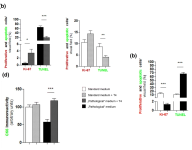cs3000
New member
Chronic wounds, human trial, massive beneficial effect
https://pubmed.ncbi.nlm.nih.gov/37226792/
16 days for complete wound closure with topical t3 applied vs 60 days for the honey cream treated group
 <- systemic effect delivered i.p so not just when used on skin directly
<- systemic effect delivered i.p so not just when used on skin directly
^ used on skin in mice, dose 150ng
& this one is interesting - showing thyroxine (T4) also works to restore wound healing and when conditions are set up for hypoxic and high oxidative stress tissue which otherwise prevented healing

https://pubmed.ncbi.nlm.nih.gov/37226792/
16 days for complete wound closure with topical t3 applied vs 60 days for the honey cream treated group
https://academic.oup.com/endo/article/145/5/2357/2878224?login=false*The mean time to complete wound closure in the routine care group was about 60.6 days, while it was 15.9 and 16.4 days in T3 and T3/Ins groups, respectively
At the time of study termination, all participants in each of the T3 or T3/Ins groups were free of symptoms based on the REEDA score**, while about 40% of participants in the control group were detected with each of grades 1, 2, or 3.
. To examine TH requirement for optimal wound healing, we contrasted TH-deficient vs. ip T3-treated mice.
Four days after wounding, ip T3-treated mice had twice the degree of wound closure as hypothyroid mice (P < 0.001).
By RT-PCR, K6a and K17 gene expression from control mouse skin was greater than from hypothyroid mouse skin: 5- (P < 0.001) and 1.7-fold (P < 0.05), respectively.
T3 is necessary for the keratinocyte proliferation required for optimal wound healing. T3 exerts influence by stimulating expression of the wound-healing keratin genes. Thus, for hypothyroid patients undergoing surgery that cannot be delayed until euthyroidism is achieved, our data support T3 treatment for the perioperative period.
 <- systemic effect delivered i.p so not just when used on skin directly
<- systemic effect delivered i.p so not just when used on skin directly^ used on skin in mice, dose 150ng
Daily topical application of 150 ng T3 resulted in 58% greater wound closure relative to wounds on the same animals receiving vehicle alone
& this one is interesting - showing thyroxine (T4) also works to restore wound healing and when conditions are set up for hypoxic and high oxidative stress tissue which otherwise prevented healing
(and also boosted in standard tissue environment)
Thyroxine restores severely impaired cutaneous re-epithelialisation and angiogenesis in a novel preclinical assay for studying human skin wound healing under “pathological” conditions ex vivo - Archives of Dermatological Research
Impaired cutaneous wound healing remains a major healthcare challenge. The enormity of this challenge is compounded by the lack of preclinical human skin wound healing models that recapitulate selected key factors underlying impaired healing, namely hypoxia/poor tissue perfusion, oxidative...link.springer.com
we sought to further mimic “pathological” wound healing conditions by culturing experimentally wounded, healthy full-thickness frontotemporal skin from three healthy female subjects for three days in either serum-free supplemented Williams’ E medium or in unsupplemented medium under “pathological” conditions (i.e. hypoxia [5% O2], oxidative damage [10 mM H2O2], absence of insulin, excess glucose)
Indeed, thyroxine administration sufficed to rescue re-epithelialisation (p < 0.001) and promoted both epidermal keratinocyte proliferation (p < 0.01) and angiogenesis in terms of CD31 immunoreactivity and CD31 positive cells under “pathological” conditions (p < 0.001) ex vivo.

Last edited:
